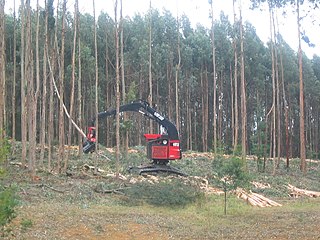
Wood is a structural tissue found in the stems and roots of trees and other woody plants. It is an organic material – a natural composite of cellulose fibers that are strong in tension and embedded in a matrix of lignin that resists compression. Wood is sometimes defined as only the secondary xylem in the stems of trees, or more broadly to include the same type of tissue elsewhere, such as in the roots of trees or shrubs. In a living tree it performs a support function, enabling woody plants to grow large or to stand up by themselves. It also conveys water and nutrients between the leaves, other growing tissues, and the roots. Wood may also refer to other plant materials with comparable properties, and to material engineered from wood, woodchips, or fiber.
Black bear or Blackbear may refer to:

Cocobolo is a tropical hardwood of Central American trees belonging to the genus Dalbergia. Only the heartwood of cocobolo is used; it is usually orange or reddish-brown, often with darker irregular traces weaving through the wood. The heartwood changes color after being cut and can be polished to a lustrous, glassy finish; being quite dense, sometimes having a specific gravity of over 1.0, it will sink in water. The sapwood is a creamy yellow, with a sharp boundary between it and the heartwood.

Pulpwood is timber with the principal use of making wood pulp for paper production.
Wake or The Wake may refer to:
Devil's Backbone may refer to:
Carter(s), or Carter's, Tha Carter, or The Carter(s), may refer to:

In trees, heart rot is a fungal disease that causes the decay of wood at the center of the trunk and branches. Fungi enter the tree through wounds in the bark and decay the heartwood. The diseased heartwood softens, making trees structurally weaker and prone to breakage. Heart rot is a major factor in the economics of logging and the natural growth dynamic of many older forests. Heart rot is prevalent throughout the world affecting all hardwood trees and can be very difficult to prevent. A good indication of heart rot is the presence of mushrooms or fungus conks on the tree.
The Purple Heart is a United States military decoration.

Senegalia catechu is a deciduous, thorny tree which grows up to 15 m (50 ft) in height. The plant is called khair in Hindi, and kachu in Malay, hence the name was Latinized to "catechu" in Linnaean taxonomy, as the type-species from which the extracts cutch and catechu are derived. Common names for it include kher, catechu, cachou, cutchtree, black cutch, and black catechu.

Ramial chipped wood (RCW), also called BRF, is a type of woodchips made solely from small to medium-sized branches. The adjective "ramial" refers to branches (rami). RCW is a forest product used in agriculture for mulching and soil enrichment. It may be laid on top of the soil, mixed into it, or composted first and then applied.
Elk Creek Wildlife Management Area is located on 6,004 acres (2,430 ha) east of Wylo in Logan and Mingo counties, West Virginia. The wildlife management area was established in 2008 on land leased by the West Virginia Division of Natural Resources from Heartwood Forestland Fund II, L.P.
The term hardwood is used to describe wood from non-monocot angiosperm trees. It can also refer to:
Heartwood Forest is a planned forest in Hertfordshire, England. The site covers 347 hectares, the largest continuous new native forest in England.

In woody plants, a tylosis is a bladder-like distension of a parenchyma cell into the lumen of adjacent vessels. The term tylosis summarises the physiological process and the resulting occlusion in the xylem of woody plants as response to injury or as protection from decay in heartwood. It is a key process in wall one of the compartmentalization of decay in trees (CODIT) and other woody plants.

Heart pine refers to the heartwood of the pine tree, which is the non-living center of the tree trunk, while the sapwood is the outer living layer which transports nutrients.
Hartwood is a village in Scotland.
This page is based on this
Wikipedia article Text is available under the
CC BY-SA 4.0 license; additional terms may apply.
Images, videos and audio are available under their respective licenses.







